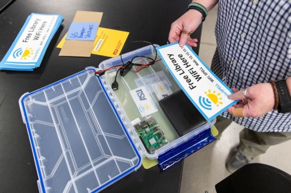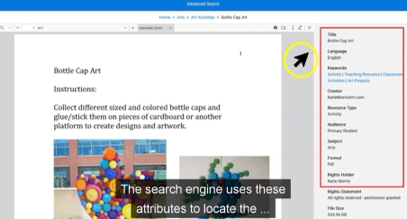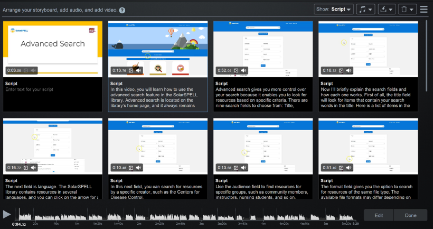
2024 VOL. 11, No. 1
Abstract: Digital and information literacy skills are necessary to succeed in today’s knowledge economy but for the millions of people in the world without internet access, a frustrating Catch-22 exists: How can they develop digital literacy skills without internet access? When they get access, what good is the internet to them if they don’t have the skills to use it productively? One answer is an offline digital library called SolarSPELL. This report from the field describes a series of instructional videos the author created to foster digital and information literacy skills among novice SolarSPELL users.
Keywords: SolarSPELL, digital literacy, digital divide, information literacy, technology
A blurry photo shows a smiling young man flanked by palm fronds, sweaty from his hike to the top of a small hill in the dense Burmese jungle. He had managed to borrow the sole satellite phone in his remote village for his journey to the nearest place — the only place — where he could connect to the outside world.
This young man’s story is not unique. Modern education in the resource-constrained countries is a challenge. Without access to reliable electricity and the internet, students (and teachers) not only miss out on learning, they fall behind on the digital literacy skills they need to thrive in a 21st century knowledge economy, further exacerbating what is known as the “digital divide.” In fact, scholars have identified three levels of digital divides, acknowledging that equal access to technology does not ensure equal outcomes (Hosman & Comisso, 2020; Ma et al., 2019; Ogbo et al., 2021). Consequently, simply providing remote or impoverished communities with internet access is not an adequate remedy. The internet is a tool, and the potential of any tool is realised only through the knowledge and skill of its operator. In order to harness the power of the internet to generate life-improving outcomes, users need to develop the complementary skills of information literacy and digital literacy.
Information literacy is the ability to “recognize when information is needed and…locate, evaluate, and use effectively the needed information” (American Library Association, n.d.), while digital literacy includes the ability to “use online digital sources, including digital libraries, to effectively seek different knowledge resources by using search engines, correctly locating required information, and using online support when needed” (Abunadi, 2018, p. 121).
Developing these skills in remote, unconnected areas is incredibly difficult. An innovative offline digital library called SolarSPELL offers a solution, enabling users to acquire digital and information literacy skills before the internet reaches their community. This report from the field focuses on a series of video tutorials that the author created to teach new users with limited technological experience how to navigate the SolarSPELL library.
This report describes the context and aims of the project, explains the design process, assesses the impact on development, and discusses plans for future work.
The Solar Powered Educational Learning Library (SolarSPELL) is a small, portable digital library that is stored on a Raspberry Pi microcomputer (Figure 1). The solar-powered microcomputer, functioning as a server, creates an offline Wi-Fi hotspot, which users connect to with their own device, such as a laptop, tablet, or smartphone. Many people are surprised to learn that “Wi-Fi” is not synonymous with “internet.” Wi-Fi allows devices in a local network to connect to each other and functions independently from the internet. Because of this, anyone within range of the SolarSPELL library’s Wi-Fi signal can connect to the library offline. Users can then browse or search the library’s open-source content in a way that imitates the experience of being online.

(www.SolarSPELL.org)
The SolarSPELL team, based at Arizona State University in the United States, partners with government agencies and ministries as well as other organisations to distribute digital libraries to schools and communities in Africa, the Middle East, and the Pacific Islands (Deganis et al., 2021; Hosman, Walsh et al., 2020; “About the SolarSPELL,” n.d.). To date, SolarSPELL libraries have reached around 300,000 people in 14 different countries (“Impact,” n.d.), and users include teachers, students, school administrators, healthcare practitioners, farmers, community members and Peace Corps Volunteers.
Because building capacity in first-time library users is a top priority of the SolarSPELL initiative, the team conducts multi-day train-the-trainer sessions for every new implementation site. These trainings may include in-person or virtual workshops to teach new users how to operate the digital library (Hosman, Walsh et al., 2020; “About the SolarSPELL,” n.d.).
Although the SolarSPELL initiative has experienced success in terms of library adoption and usage (Hosman, Walsh, et al., 2020), not all users are comfortable with the new technology. Quan-Haase et al. (2014) identified “technology confidence” as a key barrier to technology adoption, a finding that was reflected in a 2020 survey of teachers in Fiji who had received SolarSPELL libraries the prior year. When the teachers were asked how often they used the digital library either for classroom use or self-training, approximately one-third of respondents answered, “not often,” citing fear as a cause for avoidance (Hosman, Gómez Zermeño et al., 2020). Recognising a need to offer additional support to novice users, the SolarSPELL team expressed a desire to create a series of “walk-through” video tutorials aimed at teaching users how to navigate the library, find the right resources and use these resources effectively.
Prior to creating the videos, the author met with members of the SolarSPELL team to learn about the characteristics of SolarSPELL library users and clarify the overarching goals of the project. The author explored the existing resources in the library and developed a broad conceptual framework for the video tutorials. Following stakeholder discussions and exploratory research, the author proposed a collection of instructional videos, eventually twelve in all, to teach users how to navigate and search the SolarSPELL library’s resources. Learning objectives for each video were developed, and the following points of instruction were chosen:
• Website navigation
o Clicking on the company logo to return to the home page
o Understanding a site map or index
o Following a website’s breadcrumb trail
o Locating an organisation’s contact information
• Effective search strategies
o Using Boolean operators to expand or limit search results
o Applying multiple search filters
o Using an asterisk to find multiple variants of a word
o Using quotation marks to search for a specific phrase
• Technical knowledge
o Adjusting volume on a video
o Downloading and saving documents
o Understanding the difference between file types (pdf, doc, mp3, mp4)
Once a project timeline was established, the author began a six-step iterative design process to create video prototypes:
1. Write a script
2. Plan corresponding on-screen actions
3. Create a storyboard
4. Record a prototype video
5. Send the prototype to the SolarSPELL team for feedback
6. Revise the prototype and re-record as needed
Prototype videos were sent to the SolarSPELL team for feedback and evaluation through several revision cycles. Based on this feedback, videos were edited for content, clarity, flow and length. To reduce cognitive load, each video was designed to be three to five minutes long (Clark & Mayer, 2016). Narrated step-by-step instructions were accompanied by visual scaffolding techniques such as a highlighted cursor, colored graphics and captions (Rodemer et al., 2021) (Figure 2).

Microsoft Word and PowerPoint were used to write the scripts and design supplementary visual aids, such as summary slides and standardised introduction slides. Storyboards were created in ScreenPal (formerly Screencast-o-Matic). ScreenPal was also used to add narration, video, background music and captions. Narration was recorded with a Blue Snowball microphone (Figure 3).
Prototype videos were uploaded to ScreenPal and shared with the SolarSPELL team via Google Docs. Members of the team offered feedback and suggestions through email, Google Docs and video chats. Throughout the revision process, video scripts and on-screen actions were adjusted to meet the needs of SolarSPELL end users, most of whom tend to be non-native English speakers with limited technical experience.

Adopting new technology requires people to step out of their comfort zones and onto an intimidating new learning curve, but the SolarSPELL video tutorials can provide a soft landing. Because a person’s attitude toward new technology greatly impacts his or her willingness to use it, technology that is perceived to be both useful and easy to use is more likely to be adopted (Puah et al., 2022). The tutorials offer point-of-need instruction, enabling technological novices to use the SolarSPELL library right away and start building digital and information literacy skills.
Research data illustrate the transformative power that knowledgeable SolarSPELL users can have in their communities. Studies conducted in the Pacific Islands nation of Vanuatu found statistically reliable evidence of improved health outcomes among SolarsSPELL users versus non-users. These beneficial outcomes included reduced healthcare spending and decreased incidents of preventable diseases like diabetes and heart disease (Erspamer, 2019; Ross et al., 2022).
SolarSPELL is an innovative educational initiative with a proven impact (Hosman, et al., 2020; Hosman, et al., 2020), and the video tutorials described in this report have the potential to widen the library’s reach by making it more accessible to novice users. The videos help users start developing information literacy by showing them how to search effectively for materials, evaluate search results and use appropriate techniques for expanding or narrowing a search. But this project is about far more than just teaching people how to navigate a digital library. SolarSPELL users who learn from these videos will be able to take their new information literacy skills and apply them to other contexts, engaging in deep learning that is known as “far transfer” (Epstein, 2019). A teacher in Rwanda will know how to find videos to teach her class about water conservation, a village midwife in Ethiopia will have access to life-saving medical information and a student in Micronesia will be inspired to pursue a career in STEM. These are the kinds of skills that transform lives and communities.
Future work on this project will address several opportunities for improvement. First, the video tutorials were recorded in English but many SolarSPELL users have limited English proficiency. To make these videos more accessible, foreign language subtitles in languages like Arabic, Spanish and Swahili will be added. In addition, new videos should be created for SolarSPELL’s health and agriculture libraries due to their distinct interfaces and specialised content. Another plan for future work is to improve user experience design. The video tutorials were created on a laptop and demonstrate the perspective of a computer user but one study found that the vast majority of users connect to the SolarSPELL with a tablet or smartphone (Hosman, et al., 2020). In light of this fact, additional mobile-friendly videos should be created for mobile users. The final and perhaps most important issue is the question of how to ensure that novice users find, watch and understand the video tutorials. For people with limited knowledge of digital tools, logging on to the SolarSPELL network, opening the library and finding the videos may present a challenge. These users will likely need support from experienced local facilitators. To partially address this challenge, the existing videos have been added to the SolarSPELL Training Course. This is a digital, offline course that mimics the experience of online instruction, and library users build their digital and information literacy skill sets as they work their way through the course.
In today’s knowledge economy, digital and information literacy skills are vital to education and global development. However, for the world’s unconnected millions (Petrosyan, 2023), a frustrating Catch-22 exists: Without access to the internet, how do people develop digital literacy? When they get access, what good is the internet to them if they do not have the skills to use it productively? The SolarSPELL library offers a way forward by giving users access to a vast array of digital resources in an offline environment. Video tutorials tailored to the needs of the library’s novice users meet learners where they are, placing them on the path to digital literacy. Armed with knowledge and ability, SolarSPELL users will be well-positioned to harness the power of the internet once it reaches their community.
Acknowledgements: The author would like to sincerely thank Dr. Laura Hosman, Courtney Finkbeiner, Sara Jordan, Rachel Nova, Ean Paget and Ann DeHeide for their valuable advice and contributions to this project.
About the SolarSPELL Initiative. (n.d.). SolarSPELL. https://solarspell.org/about
Abunadi, I. (2018). A technology-dependent information literacy model within the confines of a limited resources environment. Information Technology and Libraries, 37(4), 119-135. https://doi.org/10.6017/ital.v37i4.9750
American Library Association. (n.d.). Information literacy. https://literacy.ala.org/information-literacy/
Clark, R.C. & Mayer, R.E. (2016). E-learning and the science of instruction. Wiley.
Deganis, I., Haghian, P.Z., & Tagashira, M. (2021). Leveraging digital technologies for social inclusion. https://www.un.org/development/desa/dspd/wp-content/uploads/sites/22/2021/02/PB_92-1.pdf
Erspamer, B. (2019). SolarSPELL in Vanuatu: An economic evaluation. [Thesis, Arizona State University]. https://keep.lib.asu.edu/items/132407
Epstein, D. (2019). Range: Why generalists triumph in a specialized world. Riverhead Books.
Hosman, L., & Comisso, M.A.P. (2020). How do we understand “meaningful use” of the internet? Of divides, skills and socio-technical awareness. Journal of Information, Communication & Ethics in Society, 18(3), 461-479. https://doi.org/10.1108/JICES-05-2020-0055
Hosman, L., Gómez Zermeño, M.G., & Alemán de la Garza, L. (2020). SolarSPELL assessment: Impact of a solar-powered digital library as a teaching-learning resource on climate change. Sustainability, 12(16), Article 16. https://doi.org/10.3390/su12166636
Hosman, L., Walsh, C., Comisso, M.P., & Sidman, J. (2020). Building online skills in off-line realities: The SolarSPELL Initiative (Solar Powered Educational Learning Library). First Monday. https://doi.org/10.5210/fm.v25i7.10839
Impact: Making a difference. (n.d.). SolarSPELL. https://solarspell.org/impact
Ma, J.K.-H., Vachon, T.E., & Cheng, S. (2019). National income, Political freedom, and investments in R&D and education: A comparative analysis of the second digital divide among 15-year-old students. Social Indicators Research, 144(1), 133-166. https://doi.org/10.1007/s11205-018-2030-0
Ogbo, E., Brown, T., Gant, J., & Sicker, D. (2021). When being connected is not enough: An analysis of the second and third levels of the digital divide in a developing country. Journal of Information Policy, 11, 104-146.
Puah, S., Bin Mohmad Khalid, M.I.S., Looi, C.K., & Khor, E.T. (2022). Investigating working adults’ intentions to participate in microlearning using the decomposed theory of planned behaviour. British Journal of Educational Technology, 53(2), 367-390. https://doi.org/10.1111/bjet.13170
Rodemer, M., Eckhard, J., Graulich, N., & Bernholt, S. (2021). Connecting explanations to representations: Benefits of highlighting techniques in tutorial videos on students’ learning in organic chemistry. International Journal of Science Education, 43(17), 2707-2728.https://doi.org/10.1080/09500693.2021.1985743
Ross, H.M., Hosman, L., Baikie, B., Blau, E., & Simpson, C.J. (2022). SolarSPELL health and education: Global solutions with local impacts. Journal of Global Health Reports, 6, e2022050. https://doi.org/10.29392/001c.38734
Quan-Haase, Martin, K., & Schreurs, K. (2014). Not all on the same page: E-book adoption and technology exploration by seniors. Information Research, 19(2).
Author Notes
https://orcid.org/0009-0005-0199-4785
Emily Paget has been an educator for over twenty years. She works as an adjunct professor at Green River College, where she teaches English to international students. She holds a Master of Arts in Teaching English to Speakers of Other Languages (TESOL), a Master of Science in Global Technology and Development, and a professional certificate in E-Learning Instructional Design. She is currently pursuing a PhD in Innovation in Global Development with a research focus on disruptive innovation, personal disruption and women’s education. Email: emilypaget@gmail.com
Cite as: Paget, E. (2024). Online skills in an offline environment: Creating information literacy tutorials for the SolarSPELL offline digital library. Journal of Learning for Development, 11(1), 165-171.